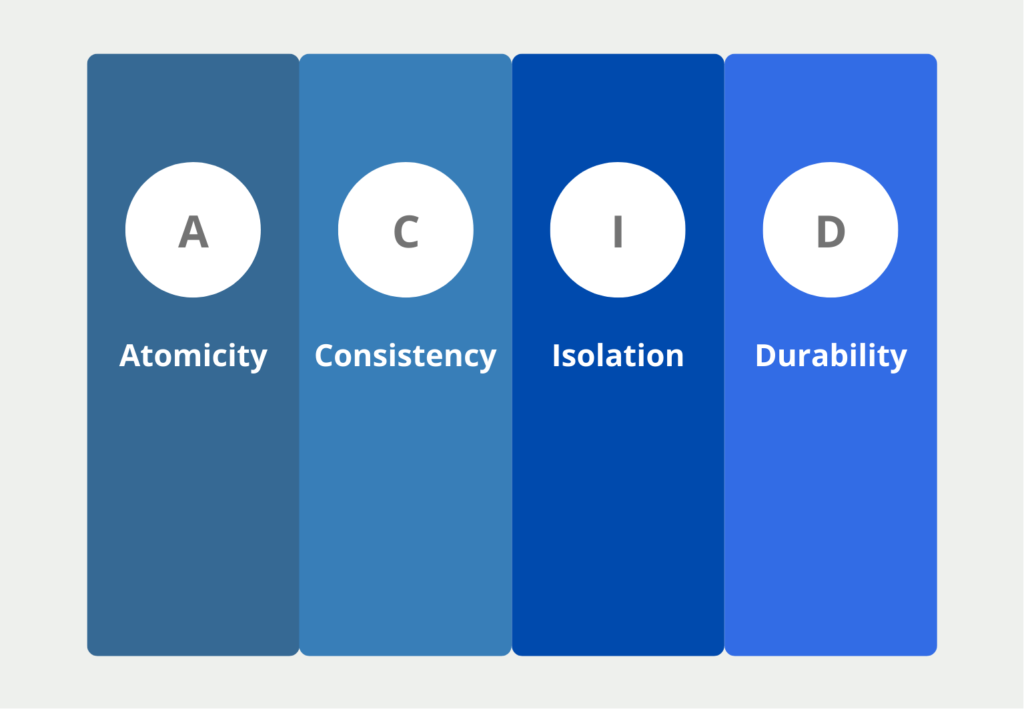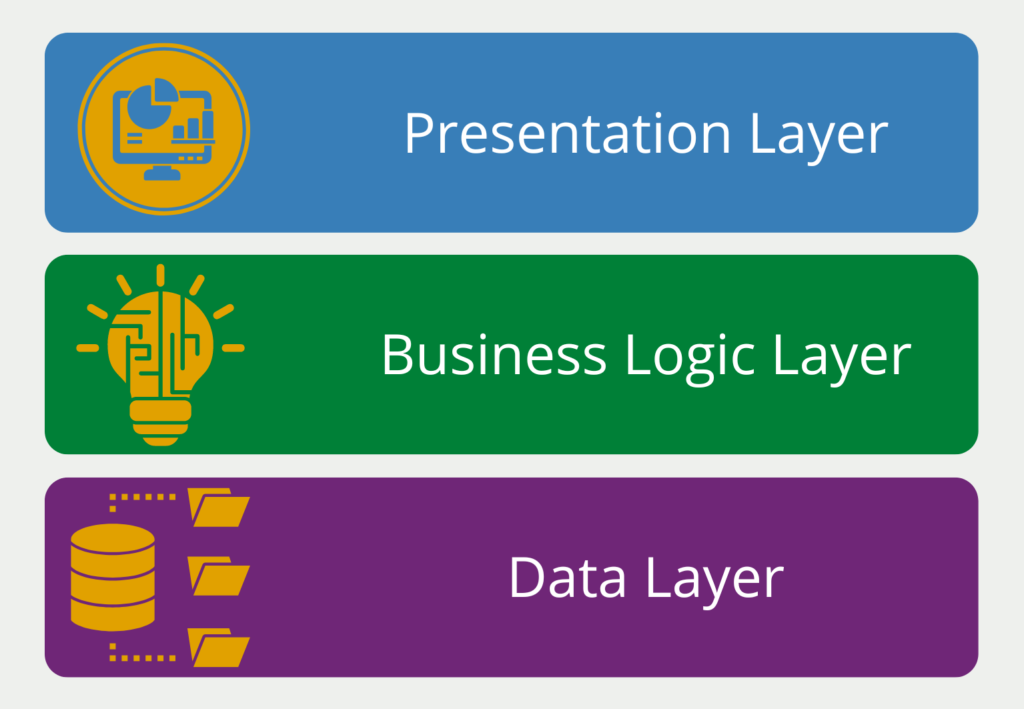Online Transaction Processing (OLTP) describes the simultaneous processing of several so-called transactions. Transactions include, for example, ATM withdrawals, online banking, or e-commerce sales.
What is Transaction Data?
Transaction data is information that accumulates in the environment of organizations and companies. In many cases, these are so-called business transactions, such as incoming or outgoing payments, new orders, or the purchase of raw materials. Transactions are indivisible and consistent.
These properties also coincide with the so-called ACID criteria of databases. Indivisibility (or atomicity in the case of databases) means that transactions are either executed in full or not at all. In other words, they are done or not done at a certain point in time. Consistency describes the property that a transaction always leaves the system in a consistent, i.e. valid, state.

In order to be able to store such transactions in a database, certain requirements are placed on the system (e.g. ACID). In addition, the demand for higher performance, i.e. the simultaneous processing of multiple transactions, has increased steadily in recent years.
What are the Characteristics of Transactions?
Transactional data is therefore treated as a special class of data because it has specific characteristics that distinguish it from other data sets. These characteristics include:
- Normalization: The normalization of transaction data is usually very high. This means that the data must be free of inconsistencies or other anomalies. This is the core data of companies, so there must be no errors, as these can have expensive consequences in the real world.
- Consistency: Transaction data has high requirements for consistency so that incorrect queries cannot cause data to change.
- Data Model: In many cases, transaction data is structured and can therefore be easily converted into a tabular form. Relational databases are therefore ideal for storing transaction data.
What is OLTP?
Due to the peculiarities of transactional data and their high demands on the databases used, Online Analytical Processing includes all tools specialized for real-time transactional data processing.
In many cases, these are relational databases, since they meet the high requirements of transactions in terms of consistency and normalization. At the same time, relational databases can usually process many queries simultaneously. However, there are also isolated NoSQL solutions that can be used for OLTP.
Online Transaction Processing Systems are characterized mainly by the following points:
- Volume: The volume of users who want to query a large amount of data at the same time is very high. In large companies, in particular, orders are processed by a very large number of people. The system must be able to handle these high loads.
- High Availability: The database cannot afford any downtime, as this has expensive consequences in real life, such as lost sales.
- Simple but frequent Data Modifications: The nature of data modification in OLTP systems is usually very similar and new records are added, such as new orders, or existing records are modified, for example, because a return occurred. However, these modifications can be very common during busy periods, especially in e-commerce stores.
- Fast Response Times: The systems are also frequently used in production operations and must therefore be able to guarantee short response times. For example, if a customer in an online store wants to view his previous orders, the query should happen very quickly so that the loading time of the website is low. Otherwise, a long loading time is perceived by the customer as poor website quality.
- Integrity: As we have already explained, transactions require a high degree of consistency to ensure the truthfulness of the data.
An online transaction processing system has three different levels. The transactions are stored on the lowest level, the so-called data layer.

The business logic layer checks whether transactions are correct and comply with previously defined rules. This is also where it is determined whether all the necessary prerequisites are in place for a transaction to be completed. Finally, the presentation layer represents the front end that the user gets to see.
What are the components of OLTP?
Online transaction processing (OLTP) is a complex system that consists of several components that work together to process transactions in real-time. These components include the database management system (DBMS), the application server, the web server, and the user interface.
The DBMS is the heart of the OLTP system and is responsible for storing and retrieving data. It is designed for high-speed data access and provides features such as transaction management, concurrency control, and data consistency. The DBMS is often optimized for OLTP workloads and has features such as indexing, caching, and in-memory storage to improve performance.
The application server is responsible for processing business logic and application code. It communicates with the DBMS to retrieve and modify data, and it can also interact with other systems, such as external APIs or other OLTP systems. The application server is typically designed for high concurrency and can handle multiple requests simultaneously.
The web server provides a user interface for the OLTP system that allows users to interact with the system through a web browser or other client application. It communicates with the application server to process user requests and retrieve data from the DBMS. The web server also performs tasks such as authentication, authorization, and management of user sessions. It is designed for high availability and reliability to ensure that users can access the system at any time.
The user interface is the component of the OLTP system that users interact with directly. It can be a web-based interface, a mobile application, or a desktop application. The user interface provides users with the ability to view data, enter data, and initiate transactions. It communicates with the web server to process user requests and retrieve data from the DBMS.
In addition to these components, OLTP systems may include other components such as middleware, messaging systems, and analysis tools. Middleware can be used to integrate different systems and applications, while messaging systems can be used to communicate between components. Analytic tools can be used to analyze data and gain insights into business transactions.
Each component of the OLTP system plays a critical role in ensuring that transactions are processed quickly, accurately, and securely. Working together, these components create a robust and reliable system that can handle high volumes of transactions and meet the needs of businesses in a wide range of industries.
What are the benefits of an OLTP system?
Online Transaction Processing (OLTP) systems offer several benefits to businesses, including:
- Real-time transaction processing: OLTP systems enable businesses to process transactions in real-time, allowing them to respond quickly to customer needs and make faster business decisions.
- Improved efficiency: By automating transaction processing, OLTP systems can reduce manual errors, streamline workflows, and improve overall business efficiency.
- Data accuracy and consistency: OLTP systems are designed for data consistency and accuracy, ensuring that data is entered correctly and that it remains consistent throughout the transaction process.
- High throughput: OLTP systems are designed for high throughput, enabling businesses to process large volumes of transactions quickly and efficiently.
- Scalability: OLTP systems can scale horizontally or vertically, allowing businesses to handle increased transaction volumes without sacrificing performance or data consistency.
- Security: OLTP systems provide a reliable and secure way to store and retrieve data, protecting sensitive information from unauthorized access or tampering.
- Improved customer satisfaction: By processing transactions quickly and accurately, OLTP systems can improve customer satisfaction and loyalty, leading to increased sales and revenue.
In summary, OLTP systems offer businesses many benefits, including real-time transaction processing, improved efficiency, data accuracy and consistency, high throughput, scalability, security, and improved customer satisfaction. These benefits can help businesses remain competitive and meet the evolving needs of their customers.
OLTP and OLAP in Comparison
The two abbreviations OLAP (for Online Analytical Processing) and OLTP (for Online Transaction Processing) are often mistakenly associated with each other because the names have a similar structure. In fact, however, the terms do not have much in common at all but describe different concepts.
Online Transaction Processing (OLTP) describes systems that specialize in the fast processing of transactions. The main focus is on making it relatively easy for the relevant people on the front end to process their transactions, for example at the checkout.
Online Analytical Processing (OLAP), on the other hand, is a platform for simpler data analysis in databases. It is therefore mainly used in the backend by business analysts or data scientists to analyze business data and find partly complex correlations that can contribute to the further development of the company.
From a technical point of view, the differences become even more obvious, as the following points compiled by IBM show:
- OLTP queries are usually based on individual data records for processing a transaction, whereas OLAP queries a large number of data records.
- In Online Transaction Processing, response time plays a major role, whereas, in Online Analytical Processing, the analyses are not time-relevant and can take longer in many cases.
- In Online Analytical Processing, the data is not modified but merely analyzed. Online Transaction Processing modifies the database with each incoming transaction.
- The storage requirements of OLTP are comparatively small because, although many transactions are stored, they have a clear structure and a limited number of columns. OLAP, on the other hand, processes large amounts of data, as it is not uncommon for information to come from different databases and be merged.
Which Applications use Online Transaction Processing?
The prevalence of OLTP systems is very high, as every business processes transactions in some way. It has experienced another boom due to the rise of e-commerce. Some of the most common applications include:
- ATMs process outgoing payments with the help of OLTP
- Credit Card Transactions
- Incoming Orders in almost all industries
- E-Commerce
- Returns Management
This is what you should take with you
- Online Transaction Processing (OLTP) describes the simultaneous processing of several so-called transactions.
- Transactions have some requirements on the underlying databases, such as high consistency and fast data processing.
- The architecture of OLTP is usually divided into three levels, namely the presentation level, business logic level, and data storage level.
- OLTP and OLAP share much of their name but are very different. The main difference is that OLTP continuously adds new transactions to databases, while OLAP only deals with data analysis.
What is OpenAPI?
Explore OpenAPI: A Comprehensive Guide to Building and Consuming RESTful APIs. Learn How to Design, Document, and Test APIs.
What is Data Governance?
Ensure the quality, availability, and integrity of your organization's data through effective data governance. Learn more here.
What is Data Quality?
Ensuring Data Quality: Importance, Challenges, and Best Practices. Learn how to maintain high-quality data to drive better business decisions.
What is Data Imputation?
Impute missing values with data imputation techniques. Optimize data quality and learn more about the techniques and importance.
What is Outlier Detection?
Discover hidden anomalies in your data with advanced outlier detection techniques. Improve decision-making and uncover valuable insights.
What is the Bivariate Analysis?
Unlock insights with bivariate analysis. Explore types, scatterplots, correlation, and regression. Enhance your data analysis skills.
Other Articles on the Topic of OLTP
Microsoft, IBM, and Oracle offer detailed articles on online transaction processing, which were also used as sources for this article:

Niklas Lang
I have been working as a machine learning engineer and software developer since 2020 and am passionate about the world of data, algorithms and software development. In addition to my work in the field, I teach at several German universities, including the IU International University of Applied Sciences and the Baden-Württemberg Cooperative State University, in the fields of data science, mathematics and business analytics.
My goal is to present complex topics such as statistics and machine learning in a way that makes them not only understandable, but also exciting and tangible. I combine practical experience from industry with sound theoretical foundations to prepare my students in the best possible way for the challenges of the data world.





